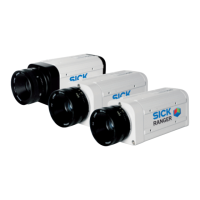Chapter 7 Reference Manual
Ranger E/D
82 ©SICK AG • Advanced Industrial Sensors • www.sick.com • All rights reserved
Ranger E Parameters
Parameter Description
Edit while
measuring
Enable Used for activating or deactivating this component in the
configuration.
0 = Deactivated
1 = Activated
Start row The first sensor row to acquire data from.
Values: 0–511. Default value: 0.
Number of rows The number of rows to acquire algorithm data from. This
value should be a multiple of 16.
Values: 16–512. Default value: 64.
Range axis Specifies whether the rows should be numbered from
the top or the bottom of the ROI when determining the
Xsum value. Default value: 0.
0 = First row is at top of ROI
1 = First row is at bottom of ROI
x
Binning Specifies whether or not sensor rows should be binned
before AD conversion. Binning increases the profile rate,
but decreases the 3D resolution.
Values: 1,2. Default value: 1 (no binning)
Exposure time The time in microseconds during which the sensor is
exposed to light.
Values: 10–50 000. Default value: 5 000.
x
Laser pulse time Length of the pulse on the laser trigger output (Out0) in
microseconds.
Values: 10–50 000. Default value: 0 (no pulsed laser)
The pulse time must be shorter than the exposure time
and the cycle time (set in the Measurement configuration).
x
Pulse polarity Polarity of the laser pulse. Default value: 1.
0 = Active low
1 = Active high
x
Gain Factor to amplify the analog sensor data before AD
conversion.
Values: 1, 3, 4. Default value: 1 (No amplification).
x
Threshold The noise level – that is, the minimum light level to
consider as a valid laser position.
Values: 0–255. Default value: 10.
Note: a too low setting of the threshold might increase
the amount of noise, while a too high setting might lead
to loss of data.
x
Ad bits Number of bits to perform AD conversion of sensor data
on. A lower number of bits slightly decreases the 3D
resolution.
Values: 5–8. Default value: 7.
x
The acquisition speed of a configuration using the Hi3D component depends mainly on the
setting for the ROI and the number of AD bits. The maximum speed at 5–7 bit AD conver-
sion is shown in the following figure.

